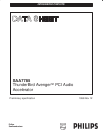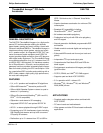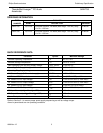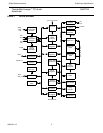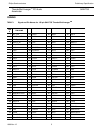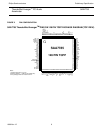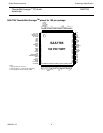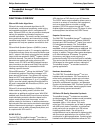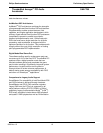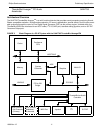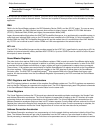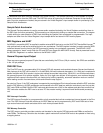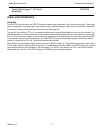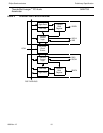
ThunderBird Avenger
TM
PCI Audio SAA7785
Accelerator
Philips Semiconductors Preliminary Specification
1999 Nov 12 9
FUNCTIONAL OVERVIEW
QSound 3D Audio Algorithms
QSound Labs most advanced algorithms for 3D
virtualization, multichannel processing, audio mixing
and wavetable synthesis result in unsurpassed 3D
audio. QSound’s Q3D
TM
is the only solution developed
natively for speakers and therefore requires no
crosstalk cancellation. The result is a wide “sweetspot”,
strong positional perception and insensitivity to head
movement and position. Listeners can enjoy a true 3D
experience with only two speakers connected to their
PC.
QSound Multi-Speaker System
TM
(QMSS
TM
) uses a
proprietary stereo-to-quad or 5.1 remapping algorithm
to transform ordinary stereo into more immersive quad
and 5.1 outputs. Not simply mirroring the front speaker
output to the rear speakers, QMSS
TM
creates 4 and 5.1
individual channels. The result is DirectSound games
become more realistic with action all around the
listener; music CD, MP3 and MIDI playback become
more immersive; and stereo and Dolby ProLogic film
clips become theatre-like in presentation without
needing a specific decoder.
QSound3DInteractive
TM
utilizes the ActiMedia
TM
DSP
to interactively position DirectSound streams in 3D
space around the listener. Four different 3D engines,
based on HRTF and patented QSound technology,
render sound over headphones, 2, 4 or 5.1 speakers.
Q3DI
TM
uses the industry standard DirectSound3D
TM
API and is compatible with DirectSound, EAX
TM
, and
A3D1.0
TM
applications.
QSound Environmental Modeling
TM
(QEM
TM
) adds
further realism by adding reverb, occulsion and
obstruction as additional positional ques. With QEM
enabled, each DirectSound3D sound source receives
reverb simulating acoustic reflections based on the
regions reverb present and the sources’ current
position relative to the listener. In addition obstruction
and occlusion filters are used to simulate the acoustical
effects of barriers and openings in a games virtual 3D
environment such as walls, doorways and pillars, and
is compliant with I3D Level 2.0.
S/PDIF OUT/IN
The SAA7785 ThunderBird Avenger
TM
provides an
integrated S/PDIF OUT port enabling users to output
AC3 data from a DVD directly to an AC3 decoder.
The S/PDIF stereo output capability allows users to
connect to a variety of consumer audio equipment,
such as a stereo receiver, minidisk, or digital
speakers. S/PDIF IN support through the I
2
S port
enables digital connection from a CD player or other
audio equipment that utilizes the S/PDIF format.
Superior Concurrency
The SAA7785 ThunderBird Avenger
TM
combines its
64 hardware input buffers with software (256 MIDI
channels and 192 DirectSound
TM
inputs) for a total of
512 simultaneous streams. The ThunderBird
Avenger
TM
can process 64 combined audio and
wavetable voices in hardware plus an additional 192
audio streams using QSound’s efficient MMX host
engine. In addition, Avenger offers game developers
up to 96 simultaneous 3D streams. For greater
concurrency and higher music polyphony a
professional quality 256 voice soft-synth is available.
This can be used for all music synthesis reserving all
256 streams for other audio sources, making the
ThunderBird Avenger
TM
an excellent solution for
gaming applications.
Hardware Acceleration
The SSA7785 ThunderBird Avenger
TM
is a true
hardware audio accelerator. CPU consumption is
minimized by processing sample rate conversion,
panning, mixing, 3D virtualization, filtering, music
synthesis, multichannel conversion, and gameport
functions in the hardware DSP. This frees up the host
CPU to perform other tasks, boosting graphic frame
rates and raising system benchmarks.
320 Voice CD Quality Wavetable Synthesis
ThunderBird Avenger
TM
includes two wavetable
synthesis engines. When hardware mode is enabled,
the ActiMedia
TM
DSP can produce up to 64
wavetable 44Khz, 16 bit voices. This mode
minimizes CPU consumption and is ideal for games
with MIDI music tracks. In addition, a professional
quality soft-synth can produce up to 256 voices
including special effects. The soft-synth is
configurable and can be optimized for highest quality
with pure music applications or for minimum CPU
consumption in gaming applications. Combining both
hardware and software synthesizers allows for 320



